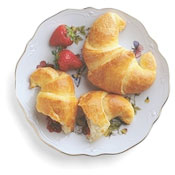|
|
Cuisine Glossary
| You have reached our International Cuisines and information on all aspects of a countries cuisine.
We will try to explain the culture, significant influences, climate, and other factors that have come together to create a distinct style. For example: Spanish, Mexican or Japanese. |
French Cuisine
 |
Despite a common pan-gallic chauvinism, French cooking is not a monolith: it ranges from the olives and seafood of Provence to the butter and roasts of Tours, from the simple food of the bistro to the fanciful confections of the Tour d'Argent. However, it all shares a seriousness about food. Throughout the country, French cooking involves a large number of techniques, some extremely complicated, that serve as basics. Any cook will tell you that French food will not tolerate shortcuts in regard to these fundamentals. Because mastery of sauces or pastry doughs is the center of the culinary arts, recipes themselves remain classic and constant. In a way similar to Japanese cuisine, it is expected that even the simplest preparation be undertaken in the most careful manner, which means disregarding the amount of time involved. This is one reason why French cooking has always seemed so daunting on the other side of the Atlantic. Americans love nothing more than combining innovation with timesaving; it is the particular genius of the United States, and it couldn't be more at odds with the French aesthetic. A French meal might begin with a hot hors d'oeuvre followed by soup, main course, salad, cheese, and finally dessert. The French operate with a strong sense that there is an appropriate beverage for every food and occasion. Source: HungryMonster Writers |




